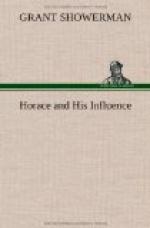In the index of Horacio en Espana are to be found the names of 165 Castilian translators of the poet, 50 Portuguese, 10 Catalan, 2 Asturian, and 1 Galician. There appear the names of 29 commentators. Of complete translations, there are 6 Castilian and 1 Portuguese; of complete translations of the Odes, 6 Castilian and 7 Portuguese; of the Satires, 1 Castilian and 2 Portuguese; of the Epistles, 1 Castilian and 1 Portuguese; of the Ars Poetica, 35 Castilian, 11 Portuguese, and 1 Catalan. The sixteenth century translators were distinguished in general by facility and grace, the freshness and abandon of youth, and a considerable degree of freedom, or even license. Those of the eighteenth show a gain in accuracy and a loss in spirit.
v. IN ENGLAND
The appeal of Horace in England and English-speaking countries has been as fruitful as elsewhere in scholarship, with the possible exception of Germany. In its effect upon the actual fibre of literature and life, it has been more fruitful.
A review of Horatian study in England would include the names of Talbot and Baxter, but, above all, of the incomparably brilliant Richard Bentley, despite his excesses, themselves due to his very genius, the most famous and most stimulating critic and commentator of Horace the world has seen. His edition, appearing in 1711, provoked in 1717 the anti-Bentleian rejoinder of Richard Johnson, and in 1721 the more ambitious but equally unsuccessful attempt to discredit him by the Scotch Alexander Cunningham. The primacy in the study of Horace which Bentley conferred upon England had been enjoyed previously by the Low Countries and France, to which it had passed from Italy in the second half of the sixteenth century. The immediate sign of this transfer of the center to northern lands was the publication in 1561 at Lyons of the edition containing the text revision and critical notes of Lambinus and the commentary of the famous Cruquius of Bruges. The celebrated Scaliger was unfavorably disposed to Horace, who found a defender in Heinsius, another scholar of the Netherlands. D’Alembert, who became a sort of Ars Poetica to translators, published his Observations at Amsterdam in 1763.
An account of the English translations of the poet would include many renderings of individual poems, such as those of Dryden, Sir Stephen E. De Vere, and John Conington, and the version of Theodore Martin, probably the most successful complete metrical translation of Horace in any language. It is literally true that “every theory of translation has been exemplified in some English rendering of Horace.”
It is in the field of literature, however, that the manifestations of Horace’s hold upon the English are most numerous and most significant. Even Shakespeare’s “small Latin” includes him, in Titus Andronicus:
Demetrius.
W_hat’s here? A scroll, and
written round about!_
L_et’s see_:




